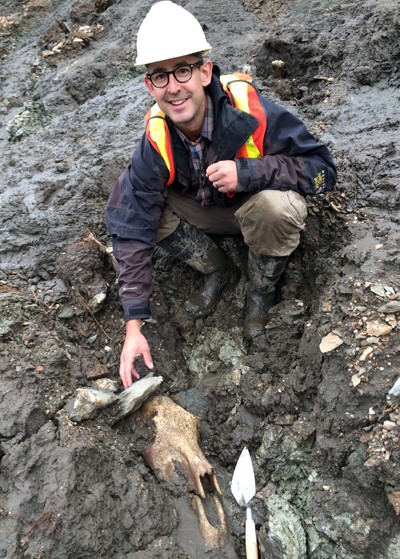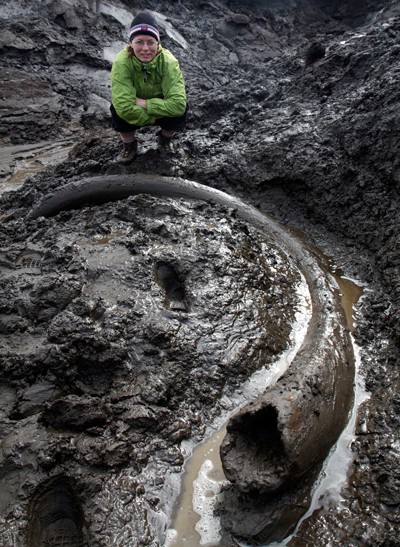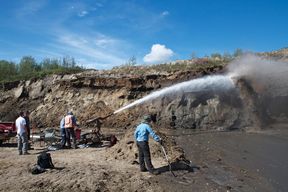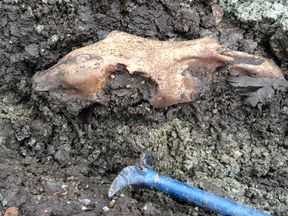In the process, the ancient soil is also expected to turn up more than 2,000 pieces of ice age moose, bison, beavers, mammoth and camels. Some of them so well-preserved in the frozen ground, in fact, that there is still rotting flesh attached.

Earlier this month, a Schmidt Mining operation at Canyon Creek turned up the intact skull of an ice age horse that went extinct more than 12,000 years ago — about the time human civilization was forming in Mesopotamia.
Past finds have included an entire mammoth skull, a mummified horse still bearing the bite marks of an ancient wolf, an entire frozen ferret from 40,000 years ago and a 700,000-year-old horse bone that yielded the world’s oldest sequenced genome.
“Five years ago, if you told anyone you could get DNA from a bone that was almost a million years old, they would have laughed at you,” said Grant Zazula, the Yukon government’s official palaeontologist.
In Alaska, gold miners have even uncovered the frozen body of a 38,000-year-old Steppe bison.
Nicknamed “Blue Babe,” the specimen was so well preserved that University of Alaska researchers were able to prepare a stew using portions of the animal’s neck meat.

“It’s remarkable how much material comes out of these gold mines—we’re just trying to keep on top of it,” said Mr. Zazula.
For the rest of the summer, two Yukon government employees have been posted to a camp outside Dawson City and tasked exclusively with driving around to collect the day’s bounty of ancient bone fragments.
“When the sun shines, we make hay,” said Mr. Zazula.
Only seven years ago, the Whitehorse-based warehouse holding the territory’s ice age artifacts held only 5,000 specimens. Now, the collection is up to 25,000, with at least 3,000 more expected by September.
“We’re probably building up one of the largest collections of ice age mammals anywhere in the world,” he said.

Just like their Klondike Gold Rush predecessors, Yukon gold miners still use a process known as “placer mining”; essentially a mechanized version of panning for gold.
Often, the first step is to expose the Yukon’s gold-rich gravel by using high-pressure water hoses to clear away a top layer of silt. It is during this process of “hydraulic monitoring” that most prehistoric finds are made.
“Typically, you know you’ve found it because you smell it before you see, it,” said Duane Froese, a University of Alberta scientist who has been coming to the Klondike for 20 years. “Imagine putting something in your freezer for 40,000 years and then thawing it out.”
In fact, most placer mines are permeated by a noticeably foul smell. As Klondike silt is blasted away, it unleashes the distinctive stench of millennia-old rotting plants and animals.
“It’s like rotting ancient barnyard, and you know when you have that smell that you’re going to find a lot of ancient material,” said Mr. Zazula.
The Klondike region, along with parts of Alaska, was one of the only parts of North America not to be covered by ice sheets during the last ice age.
As a result, while soil in the rest of Canada was repeatedly smashed and churned by glaciation, the frozen Klondike ground remained as undisturbed as a graveyard. In some remote area of the northern Yukon, prospectors even talk of finding mammoth prints.

Mr. Zazula also credited the Yukon’s fossil bounty with the fact that, unlike similarly fossil-rich areas across the Arctic sea Siberia, Klondike miners are willing to play ball with paleontologists. The 2003 International Mammoth Conference even credited them with “more than a century of substantial and ongoing contributions to the study of Ice Age mammals.”
Even though a paleontological find can slow down an already short gold-mining season, Mr. Zazula said the territory’s mom-and-pop mining operations have been happily showing paleontologists around their operations ever since the Paris Natural History Museum mounted the world’s first Klondike fossil expedition in 1904.
Handing over fossils is the law, of course, but it takes much more than mere law to make a placer miner in the remote Klondike decide to call up a scientist to pick up the mammoth tusk he just found.
“Without their interest and co-operation, it wouldn’t be happening,” said Mr. Zazula.






